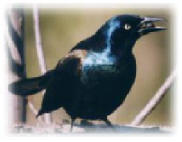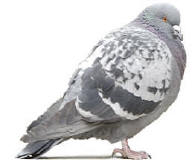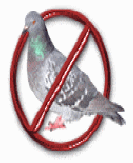|

Grackles Height/Weight
12"/6oz common
16"/7oz boat-tailed
Life Span
8 to 12 years in the wild
Flight Speed
20 to 35 mph
Range
Common Grackle: Across U.S.,
east of Rockies
BoatTailed Grackle: Along Atlantic coast and gulf of Texas seaboard
Food
Scavenger. Eats grains, seeds,
corn, insects,
food scraps, etc.
Habitat
Prefer suburban areas with access to open areas. Roost in large trees
during the winter |
|
|
Pigeon
Sparrow Swallow
Starling
Woodpecker Crow
Grackles
Grackles
Biology and Control Information

Grackles are boisterous, abundant members of the Troupial Family. Also
members of this family are the blackbirds, cowbirds and orioles. Common
grackles are found all across the mid-west and east coast. The Boat-tailed
grackles live along the eastern and southern seacoasts while great-tailed
grackles are found mostly in Texas and the south-west. Grackles are
aggressive birds who will colonize in large numbers. These birds are very
noisy, their gregarious nature is very apparent when observing their
roosting and nesting sites.
The common grackle has a green/blue or purple iridescent tinted black
plumage with a glossy purplish head, neck and breast with the female of
the species, slightly smaller and duller colored. Boat-tailed and
great-tailed grackles have very long "v" shaped tails which crease in
flight, hence the name "boat-tailed". They are similar in color to the
common grackle but are larger birds (16 inches long versus 12” long).
Female great-tails resemble the males while female boat tails are dark
brown in color Great tails differ from boat tail grackles with their
bright yellow eyes and more uniform color.
Damage
Grackles can cause several types of damage. As they are scavenging birds,
large numbers can be found at dumpsites, food courts and other human areas
where food is present. The resulting amount of fecal matter creates
unsanitary conditions and can result in physical damage from the uric
acid. They are also an agricultural pest bird because they will eat small
seedlings and damage crops.
Nesting
Grackles build a bulky yet dense nest of twigs, grasses or weeds lined
with feathers, rags or dried grass. The nest may be held in place with a
foundation of mud or cow dung. Grackles will nest in a variety of places
from willow swamps, dense brush to tall trees with trees being the most
common. Boat tail grackle nests will seldom be seen more than twenty miles
from the coast.
Breeding
Grackles breed during the spring. They usually lay four to five eggs in a
single brood for the year. Common grackle eggs are a pale green to light
brown with purple and dark brown streaks and blotches. Boat tailed
grackles have lighter blue to grayish eggs with dark streaks and blotches.
The eggs take 14 days to incubate with the young being able to fly about
three weeks later.
Cycles
Grackles have a definitive seasonal behavior. They nest and breed as one
pair or in small groups in the spring time. In the fall, the birds will
fall to form large colonies with the juveniles first forming the groups
and later joined by the adults. These large colonies can number in the
thousands. In colder, northern climates the flock will migrate south,
while southern birds will stay put or move into a more urban location.
These flocks will usually take over several trees or urban dwellings for
their evening roosting. In the winter, their feeding site may be quite far
from their roosting spot, making trapping or baiting difficult.
Control
There are numerous products and techniques available to combat nuisance
grackles. Like fellow members of the blackbird family, noisemaker units
such as the Bird-Gard, Bird Squawker and Bird Wailer units projecting
natural distress calls and frightening sounds (selection of units depends
on size of area to deter birds as well as severity of problem) plus visual
scare products like Scare Eye Balloons, Octopus, Flash Tape and the
Avikite can be used to move them from a site ->NOTE: Some times these work
and many times these methods don't work. If they are too entrenched
to be scared away, exclusion using 1-1/8" Stealth Net or Bird-Shock
electrical track on ledges will be necessary. Grackles are too nimble for
traditional mechanical ledge products. Hazing systems or Fogging a roosting winter flock
with ReJeX-iT irritant has also shown some success.
|
|
|




